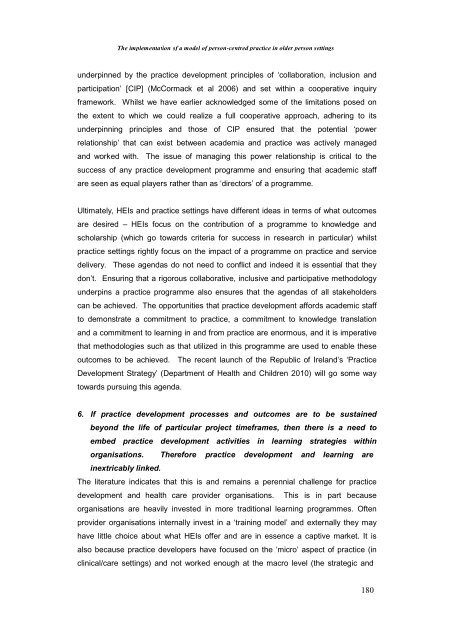The Implementation of a Model of Person-Centred Practice In Older ...
The Implementation of a Model of Person-Centred Practice In Older ...
The Implementation of a Model of Person-Centred Practice In Older ...
Create successful ePaper yourself
Turn your PDF publications into a flip-book with our unique Google optimized e-Paper software.
<strong>The</strong> implementation <strong>of</strong> a model <strong>of</strong> person-centred practice in older person settings<br />
underpinned by the practice development principles <strong>of</strong> ‘collaboration, inclusion and<br />
participation’ [CIP] (McCormack et al 2006) and set within a cooperative inquiry<br />
framework. Whilst we have earlier acknowledged some <strong>of</strong> the limitations posed on<br />
the extent to which we could realize a full cooperative approach, adhering to its<br />
underpinning principles and those <strong>of</strong> CIP ensured that the potential ‘power<br />
relationship’ that can exist between academia and practice was actively managed<br />
and worked with. <strong>The</strong> issue <strong>of</strong> managing this power relationship is critical to the<br />
success <strong>of</strong> any practice development programme and ensuring that academic staff<br />
are seen as equal players rather than as ‘directors’ <strong>of</strong> a programme.<br />
Ultimately, HEIs and practice settings have different ideas in terms <strong>of</strong> what outcomes<br />
are desired – HEIs focus on the contribution <strong>of</strong> a programme to knowledge and<br />
scholarship (which go towards criteria for success in research in particular) whilst<br />
practice settings rightly focus on the impact <strong>of</strong> a programme on practice and service<br />
delivery. <strong>The</strong>se agendas do not need to conflict and indeed it is essential that they<br />
don’t. Ensuring that a rigorous collaborative, inclusive and participative methodology<br />
underpins a practice programme also ensures that the agendas <strong>of</strong> all stakeholders<br />
can be achieved. <strong>The</strong> opportunities that practice development affords academic staff<br />
to demonstrate a commitment to practice, a commitment to knowledge translation<br />
and a commitment to learning in and from practice are enormous, and it is imperative<br />
that methodologies such as that utilized in this programme are used to enable these<br />
outcomes to be achieved. <strong>The</strong> recent launch <strong>of</strong> the Republic <strong>of</strong> Ireland’s ‘<strong>Practice</strong><br />
Development Strategy’ (Department <strong>of</strong> Health and Children 2010) will go some way<br />
towards pursuing this agenda.<br />
6. If practice development processes and outcomes are to be sustained<br />
beyond the life <strong>of</strong> particular project timeframes, then there is a need to<br />
embed practice development activities in learning strategies within<br />
organisations. <strong>The</strong>refore practice development and learning are<br />
inextricably linked.<br />
<strong>The</strong> literature indicates that this is and remains a perennial challenge for practice<br />
development and health care provider organisations. This is in part because<br />
organisations are heavily invested in more traditional learning programmes. Often<br />
provider organisations internally invest in a ‘training model’ and externally they may<br />
have little choice about what HEIs <strong>of</strong>fer and are in essence a captive market. It is<br />
also because practice developers have focused on the ‘micro’ aspect <strong>of</strong> practice (in<br />
clinical/care settings) and not worked enough at the macro level (the strategic and<br />
180
















